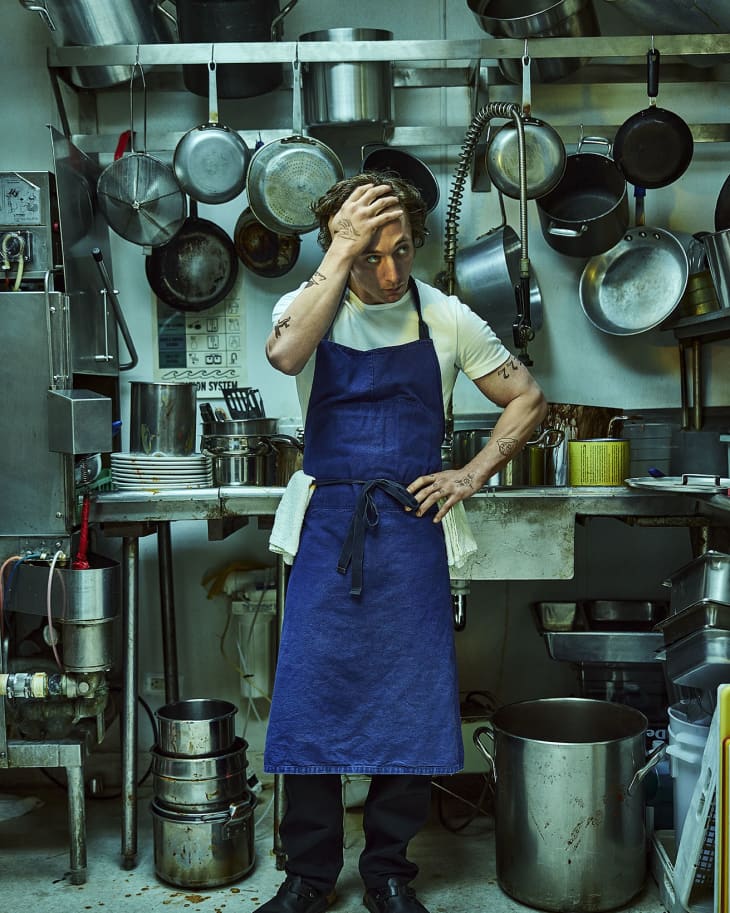I’m a Former Line Cook — Here’s What “The Bear” Got Right (and Wrong)
With a serrated knife in one hand and a cutting board in the other, I was about to begin my first day as a line cook at one of the most exclusive restaurants in New York City. My first task? Slicing around eight loaves of She Wolf Bakery’s sourdough for service that night. I thought this job would be a piece of cake. Wrong. Not long after getting started, my arm felt like it was ready to fall off my sweat-covered body. To put things into perspective, it took about two hours to neatly slice and stack thick, uniformed slices of bread and pop them into their Lexans (a type of food storage container widely used in restaurants). Welcome to the life of a line cook.
Not many people get to see the tedious reality of working in a kitchen — that is, until Hulu recently released its latest binge-worthy series, “The Bear.” The show follows James Beard Award-winning chef Carmen “Carmy” Berzatto (played by Jeremy Allen White) as he returns from abroad to resurrect his late brother’s struggling sandwich shop in Chicago. I won’t go into too much detail (I don’t want to spoil it for you), but let’s just say his presence as head chef changes everything — and not without pushback from longtime employees.
While there are plenty of TV series about food and cooking these days, very few showcase the everyday lives of the cooks behind the scenes (like me suffering through piles of toast). Along with many line cooks, chefs, and restaurateurs, I, too, was curious to see what “The Bear” got right (and wrong!) about the work environments in restaurant kitchens — also known in the industry as the “back of house.” After watching the series, I’ve got a lot to dish about.
Stream “The Bear” on Hulu here.
Right off the bat, I related to the eager sous chef Sydney Adamu (played by Ayo Edebiri). In my opinion, she most accurately portrays what it’s like to actually work on the line. She’s a quintessential hustler and has the key personality traits that run through the veins of an aspiring chef. She’s curious, hard-working, a problem solver, efficient, and fearless — and in due time, she earns respect in the kitchen.
In one scene, she gets a pretty deep cut on her finger, tends to it over the sink, and continues working despite the pain. I’ve been in that scenario too, cooking my way through an entire service after grabbing the handle of a hot pan. My entire palm was scorched, throbbing, and even blistered as the night went on. Working through a common kitchen injury, like a minor burn or a cut, speaks to the overarching energy that cooks in restaurants thrive on in order to keep going when things get heated — sometimes, quite literally. The kitchen’s philosophy is that no matter what, service must go on, and this message couldn’t have come through more clearly in this scene from “The Bear.”
Another scene that hit home for me was when Sydney panicked — and was filled with rage — when the other cooks hid her onions as a prank. This snapshot brought me back to the many hours I spent working on the garde manger station (the cold dishes and appetizer station in a kitchen), filling huge Cambros (another type of storage container kitchens use) with lemons. This involved peeling and julienning the zest, and then mincing it into a fine dust to use in various dishes. Just the thought of all that work going missing puts me into a frenzy. So, while it may seem silly to freak out over some onions, I felt her frustration.
Luckily, as much as the show captured moments of anxiety in certain scenes — orders piling up, equipment breaking, and fires starting — they balanced it out with the beautiful and magical moments that only happen in restaurant kitchens. There was the family meal scene before service starts, where one of the kitchen staff members had a moment to shine and flex their creative muscles. (I’ll never forget one of my favorite family meals where one of my sous chefs made a decadent tomato sauce spiked with crushed amaretti cookies). I loved watching them taste each other’s creations, like when Marcus (played by Lionel Boyce) serves his chocolate cake, which later becomes a menu staple. It filled me with joy when Carmy taught everyone new cooking methods, like how to make chicken piccata, all while instilling in them not to rush the preparation. It reminded me of when my chefs first taught me not to rush while I slowly, but surely, grilled bundles of ramps. I learned to focus on the food until I got each dish right — speed comes later. All of these more intimate scenes demonstrated a clear sense of camaraderie and passion in a professional kitchen, which was one of my favorite parts of being a line cook.
Maybe I just got lucky, but some of the more dramatic scenes in the show, including sabotaged stations, drug dealing, and screaming chefs, were not present in the kitchens I’ve been in. Overall, though, the show does an incredible job highlighting those very real (and thankfully rarer) moments of chaos — just with a little added Hollywood treatment.
By focusing on the characters rather than the food itself, “The Bear” does something different and gives viewers a true glimpse into the not so pretty parts of working in a kitchen. They got it right, all the way down to the blue tape. (Yes, we really do label and date everything with blue tape. And yes, we snip it with scissors for neatness — no ripping). Overall, the show was clearly able to capture the emotion, the hard work, and (most of all) the pride that makes working in the service industry so special.
